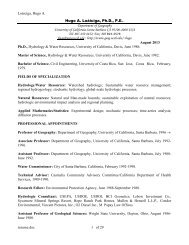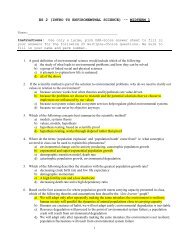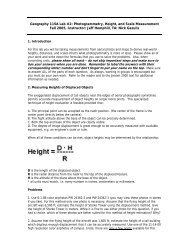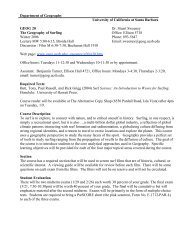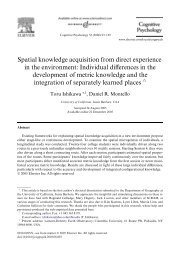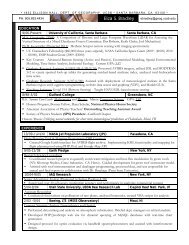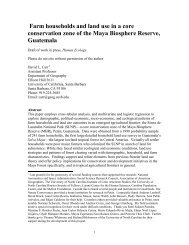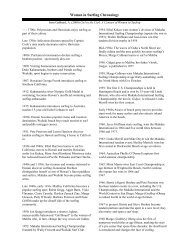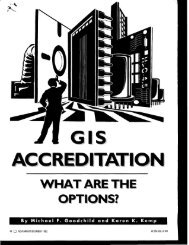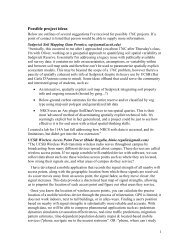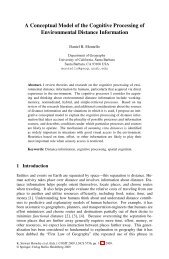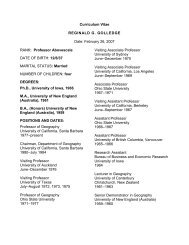Hain, M., Strecker, M.R., Bookhagen, B., Alonso, R.N., Pingel, H. and ...
Hain, M., Strecker, M.R., Bookhagen, B., Alonso, R.N., Pingel, H. and ...
Hain, M., Strecker, M.R., Bookhagen, B., Alonso, R.N., Pingel, H. and ...
You also want an ePaper? Increase the reach of your titles
YUMPU automatically turns print PDFs into web optimized ePapers that Google loves.
TC2006<br />
HAIN ET AL.: SALTA FORELAND FRAGMENTATION<br />
TC2006<br />
Figure 5. (a–d) Shown are 238 U‐ 230 Th zircon model ages <strong>and</strong> relative probabilities plotted for SA150406‐<br />
01, SA150406‐03, Ash Q, <strong>and</strong> Ash U. Dashed lines indicate maximum depositional age determined from<br />
the youngest zircon crystallization age in the population. For sample sites see Figure 2b.<br />
on both sides of the anticline but at different elevations (up<br />
to 1400 m to the west <strong>and</strong> 1130 m to the east) as a result of<br />
structurally controlled sediment ponding west of the fold<br />
(Figure 8c). Onlap against the anticline is imaged in the<br />
seismic reflection profiles (Figure 8b) <strong>and</strong> can be locally<br />
seen in outcrop (Figure 8a). The sediment‐filled western<br />
syncline exhibits growth strata. Beneath the town of Coronel<br />
Moldes (i.e., the filled eastern syncline) the La Troja Formation<br />
attains an acoustic thickness of 240 ms (two‐way<br />
traveltime, TWT) (Figure 7).<br />
[29] The modern topographic expression of the Coronel<br />
Moldes fold array may at first sight appear to be minor,<br />
especially when compared to the ranges that segment the<br />
forel<strong>and</strong>. Nonetheless, we argue that this Quaternary intrabasin<br />
structure absorbed shortening at a high rate. Perpendicular<br />
to the structures, the 19.5 km long top of the Piquete<br />
Formation was shortened to 16.5 km (Figure 8c). Given the<br />
1.3 ± 0.2 Ma age of the ash intercalated within this unit<br />
[Malamud et al., 1996] we find that the strata were shortened<br />
at a rate in excess of 3.1 ± 0.6 mm/a.<br />
4.1.2. Sierra Vaqueros <strong>and</strong> San Lorenzo Anticline<br />
[30] A second example of a Quaternary fold array in the<br />
Lerma Valley can be found near the northwestern limits<br />
of the city of Salta, the provincial capital (Figure 10). Here,<br />
the fault‐cored Sierra Vaqueros exposes Piquete Formation<br />
conglomerates, <strong>and</strong> the en echelon San Lorenzo anticline<br />
involves Quaternary strata (i.e., the La Troja Formation).<br />
The top of the Sierra Vaqueros structure is 700 m higher<br />
than the floor of the Lerma Valley. Multiple uplifted fluvial<br />
terraces attest to recent deformation <strong>and</strong> modification of the<br />
river network, unambiguously documenting that this structure<br />
is actively growing in a southwestward direction. We<br />
attribute much of the ∼140 m elevation difference between<br />
10 of 27<br />
San Lorenzo (1340 m; west of the fold) <strong>and</strong> Salta (1200 m;<br />
east of the fold) to differential Quaternary sediment storage<br />
(Figure 10); a situation very similar to the two filled synclines<br />
in the Coronel Moldes area (Figure 8c). It is interesting<br />
to note that one of the recent earthquakes located<br />
within the interior of the Lerma Valley, a magnitude 6.3<br />
event, was registered immediately east of the Sierra Vaqueros<br />
(Figure 10; USGS event ID: U.S.2010tfc3).<br />
4.1.3. Santa Barbara System Inversion<br />
[31] Previous studies have shown that Andean contractional<br />
structures in the SBS invert Cretaceous normal faults<br />
[e.g., Grier et al., 1991; Cristallini et al., 1997; Kley <strong>and</strong><br />
Monaldi, 2002]. Onlap of the Guanaco Formation just east<br />
of the Metán Range has been documented [Cristallini et al.,<br />
1997], <strong>and</strong> the Guanaco <strong>and</strong> Piquete formations are not separated<br />
by an angular unconformity [Cristallini et al., 1997;<br />
Gonzalez Villa, 2002]. Both units, however, have been subsequently<br />
folded <strong>and</strong> faulted (Figure 11) [Gonzalez Villa,<br />
2002; Kley <strong>and</strong> Monaldi, 2002]. During <strong>and</strong> after shortening<br />
the Quaternary La Troja sediments were deposited in the<br />
synclines; in Figure 11, the east sloping remnant fill surface<br />
of the central syncline reaches elevations of >1250 m whereas<br />
the fill of the eastern syncline slopes south at elevations well<br />
below 1000 m. Possible onlap relationships <strong>and</strong>/or growth<br />
strata in the central syncline have been largely eroded.<br />
Along the eastern flank of the Mojotoro Range remnant<br />
alluvial fan conglomerates pertaining to the La Troja Formation<br />
rest unconformably on the folded <strong>and</strong> eroded Mio‐<br />
Pliocene strata (Figure 11). The tectonostratigraphic patterns<br />
observed in the SBS therefore resemble those that we have<br />
documented in the Coronel Moldes area. Importantly, large<br />
volumes of Quaternary sediments are stored at high eleva-



